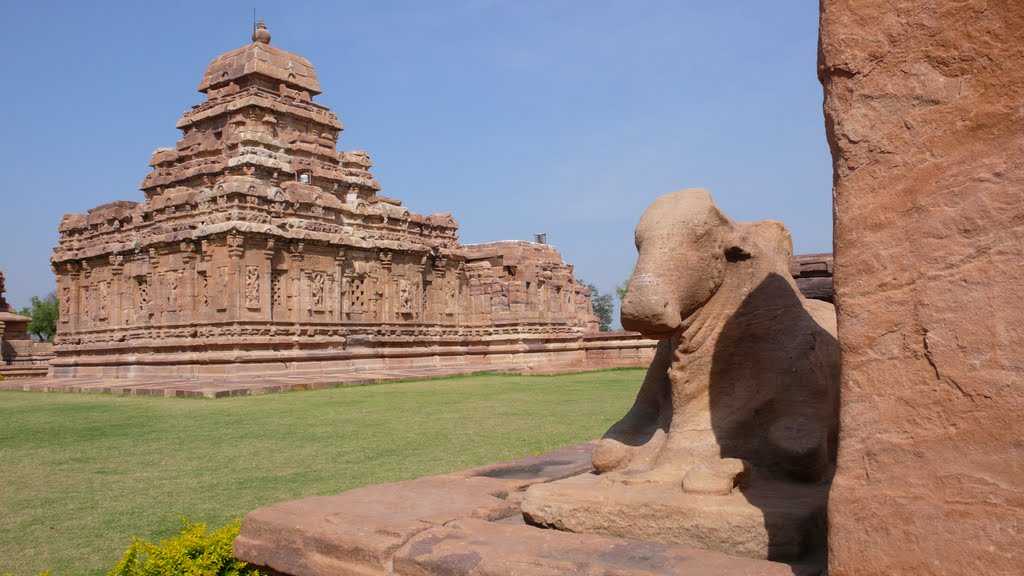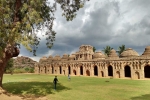"A fusion in architecture"
Pattadakal Tourism
Pattadakal is a tiny village, also known as Raktapura or Pattadakallu, houses a series of ten magnificent stone temples which date back to the 7th and 8th century. Out of these ten, nine are Hindu temples and one is a Jain temple. Lying close to the Badami and Aihole centres of Chalukya monuments, it is a protected site, managed by ASI (Archaeological Survey of India).These grand, imposing structures were inscribed as UNESCO World Heritage Site in 1987. All ten temples are majestic in their sheer size and detailed architecture, reflective of a blend of North Indian Nagara and South Indian Dravidian construction styles. Lying alongside the Malaprabha river, they have aptly earned the epithet ?cradle of Indian temple architecture?. The friezes on temple walls depict stories from various Hindu scriptures and tales, such as Mahabharata, Ramayana, Bhagavata Purana, Panchatantra, and Kir?t?rjun?ya.
The attractions in Pattadakal are the temples here which are amazingly crafted and showcase the best of various types of architecture. This blend gives the town a good deal of significance in the tourism and architectural scene. These temples offer the town its unique identity. The various temples her that one must visit are Jain temple,Papanatha temple,Galaganath temple,Sangameshwara templeand more.
Download Pattadakal PDF Guide >
What's Great?
An abode of fusion architecture. Home to several World Heritage Sites. Moderate temperature throughout the year.
What's not so Great?
Not much to explore (ideal only for a day trip). No good accommodation options and restaurants in and around Pattadakal.
For Whom
A famous historical site, Pattadakal is visited by tourists from all over. It is a favourite destination for historians and archaeologists. It is ideal for family vacations.
Site Layout
Pattadakal is an intricately woven blueprint of 10 temples, various shrines, and a conglomerate of plinths. Eight out of ten temples are huddled together in a cluster. The ninth one lies half a kilometre away from this congregation, towards the South. The Jain temple lies to the West of this assemblage, one kilometre away from the main cluster. A walkway connects all 9 Hindu temples. The Jain temple stands on the side of Pattadakal-Badami Road and therefore, easily accessible.
History
Art historians grant extreme importance to this site, mainly because it depicts Hindu and Jain social, political, and religious practices in 8th century Deccan India.
The name Pattadakal means place of coronation and this holy site was used by the Chalukya kings for the very same purpose. It was considered particularly sacred because this is where river Malprabha turned North towards the Kailasha mountain in the Himalayas.
This ancient site has been witness to rule and regimen of various kings and dynasties, including the Sangama dynasty and the Mughal empire.
All ten temples carry with them, unique stories of their own.
Temples of Pattadakal
Out of this collection of architectural masterpieces, Virupaksha temple is the grandest and most sophisticated. Built in the year 745 by Queen Lokamahadevi to immortalize her husband?s victory over the Southern Kings, it even served as the inspiration behind Kailasha temple at Ellora Caves. Mallikarjuna temple commemorates the victory of Chalukya kings over the Pallavas. Galaganatha temple depicts an eight-handed Lord Shiva, killing the demon Andhaka and wearing a yajnopavita made entirely of skulls. Jambulingeshwara, Chandrashekhara, Kadasiddheshwara, and Kashi Vishwanatha temples are small structures, all dedicated to different forms of Lord Shiva and his family. The Papanatha temple lies half a kilometre away from the cluster of other eight Hindu temples. It?s the only structure with an amalgamation of both Dravidian and Nagara styles of construction. The Sangameshwara temple is the oldest temple here but remains incomplete despite being built in several phases. The Jain Narayana temple is almost similar in structure to the nine Hindu temples. The only difference is that instead of carvings and idols of Hindu deities, it houses an idol of a Jina (a soul who conquers all passions and overcomes all imperfections).
Restaurants and Local Food in Pattadakal
The options for food can get very limited here and you might want to carry some food from home or check on your personal arrangements. You may come across popular items of the local cuisine here such asDosa, Bisi Bele Bath, Jolada Roti, Idli, Vada, Sambhar, Rasam, Kesari Bath, Mysore pak etc.
Ask a question from people who travelled to Pattadakal recently
Be the first to add a question
Submit Question
Oct-Maris the best time to visit Pattadakal
October to March are the best months to visit Pattadakal as the weather is very pleasant. Monsoons (July - September) is also a good time to visit Pattadakal.
Weather in Pattadakal
Loading...
Pattadakal in Summer (March - May)
This is the least advisable time to visit Pattadakal, owing to the unbearably hot climate, and sometimes humid days, especially during the month of April. The nights are relatively cooler than the days.
Pattadakal in Monsoon (June - September)
Pattadakal receives substantial rain during the monsoons leading to a drop in the temperature. This can be a decent time to visit as the nights are sometimes extraordinary cold.
Pattadakal in Winter (November - February)
This is the most advisable time for a trip to Pattadakal. The area is pleasant for a visit at this time, with temperatures ranging between 10 to 32 degrees Celcius.
Monthly Weather in Pattadakal
Month
Avg. Minimum (°C)
Avg. Maximum (°C)
January
15
30
February
17
33
March
19
35
April
21
38
May
23
36
June
22
30
July
21
27
August
21
27
September
20
28
October
19
30
November
16
30
December
16
30
Comments on Pattadakal
Post Your Comment


 Virupaksha Temple
Virupaksha Temple Kashiviswanatha Temple
Kashiviswanatha Temple Jain Temple
Jain Temple Sangameshwara Temple
Sangameshwara Temple Hampi
Hampi Badami
Badami Aihole
Aihole Goa
Goa Gokarna
Gokarna Bijapur
Bijapur